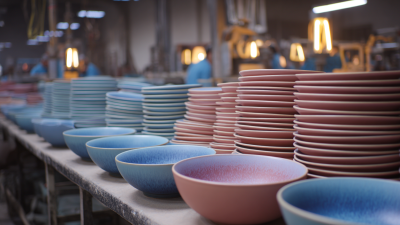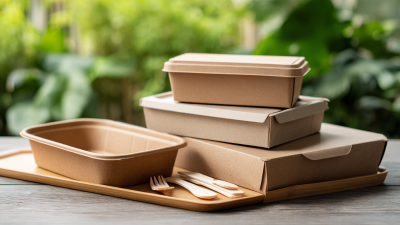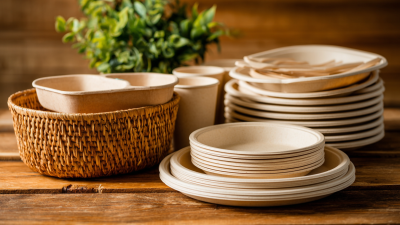In recent years, the growing awareness of environmental sustainability has prompted businesses to seek eco-friendly alternatives in packaging solutions, with degradable trays emerging as a popular choice. According to a report by Grand View Research, the global biodegradable plastics market is expected to reach USD 13.67 billion by 2027, highlighting the shift towards sustainable packaging options such as degradable trays. These trays not only reduce the dependence on traditional plastics but also cater to the increasing consumer demand for environmentally conscious products. As companies align their operations with sustainable practices, selecting the right degradable tray becomes crucial for both operational efficiency and positive brand image. This blog will guide you through the considerations involved in choosing the optimal degradable tray for your eco-friendly business, ensuring that you contribute effectively to the reduction of plastic waste while meeting your customers' needs.

In the pursuit of eco-friendliness, choosing the right biodegradable trays is critical for businesses aiming to minimize their environmental impact. A key consideration is understanding the materials used in these trays. PLA (polylactic acid) and bagasse are two popular choices; they decompose more completely than traditional plastics. According to a 2022 report by the Biodegradable Products Institute, the global market for biodegradable products is projected to reach $6.6 billion by 2027, emphasizing the growing demand for sustainable packaging solutions.
 When selecting biodegradable trays, consider their compostability standards. Look for certifications such as ASTM D6400 or EN 13432, which ensure that products will break down in composting conditions within a specific timeframe. Additionally, examine the tray's functionality and durability. A report from Smithers Pira indicates that over 70% of consumers prefer biodegradable packaging, provided that it meets their practical needs, including sturdiness for food storage.
When selecting biodegradable trays, consider their compostability standards. Look for certifications such as ASTM D6400 or EN 13432, which ensure that products will break down in composting conditions within a specific timeframe. Additionally, examine the tray's functionality and durability. A report from Smithers Pira indicates that over 70% of consumers prefer biodegradable packaging, provided that it meets their practical needs, including sturdiness for food storage.
Tip: Always request samples before making bulk purchases to assess the tray's performance in real-world scenarios.
Furthermore, factor in the end-of-life options for the trays. Collaboration with local composting facilities can enhance the sustainability of your operations. Investing in biodegradable trays not only aligns your business with eco-conscious consumers but also supports the transition towards a circular economy.
Tip: Stay informed about local regulations regarding waste management and composting, as these can affect your choice of tray materials.
When selecting degradable trays for an eco-friendly business, understanding the material options available is crucial. The three primary materials—cornstarch, paper, and sugarcane—offer distinct benefits and compostability characteristics. According to a recent report by the Biodegradable Products Institute, cornstarch-based products can decompose within 90 to 180 days under industrial composting conditions, making them a favorable choice for businesses focused on speed in waste management. Their biobased origin lends to a significant reduction in carbon footprint, positioning them as a compelling option for environmentally conscious companies.
Paper trays, made from renewable resources, are also biodegradable and recyclable. A study by the Paper and Paperboard Packaging Environmental Council indicates that over 70% of paper and paperboard products are recycled in the U.S., underlining the potential for circularity in using paper materials. However, the rate of decomposition in paper trays can vary significantly based on their treatment and local waste management practices.
Meanwhile, sugarcane, or bagasse, trays are noted for their sturdy design and ability to withstand both hot and cold foods, making them a versatile alternative. Research from the Food Packaging Forum highlights that sugarcane composts in a similar timeframe to cornstarch, generally within 90 days, and contributes to soil health when used effectively. Understanding the nuances of each material will empower businesses to make informed choices that align with their sustainability goals.
When selecting degradable trays for an eco-friendly business, it's essential to carefully evaluate their environmental impact through a Life Cycle Assessment (LCA). Recent findings indicate that bioplastics, which are derived from renewable sources, generally possess a lower environmental burden compared to traditional plastics. They show a reduced carbon footprint and enhanced biodegradability, making them an attractive option for sustainable packaging solutions. For instance, studies reveal that bioplastics can significantly mitigate the ecological footprint attributed to plastic production and end-of-life disposal.
Furthermore, projects such as upPE-T are pioneering research on the degradation of plastic waste to create biodegradable materials like PHBV, which are specifically designed for packaging uses. The environmental performance of such materials has been highlighted in various studies, indicating promising outcomes in terms of reducing plastic waste's impact on marine ecosystems. Additionally, assessments in the agrifood sector have scrutinized the life cycle of seed trays, emphasizing that transitioning to biodegradable options can play a crucial role in minimizing overall ecological damage during production, transportation, and disposal phases. These insights underline the importance of rigorous LCA methodologies in guiding businesses toward sustainable practices.
The growing demand for eco-friendly packaging solutions has led businesses to reconsider the materials they use. A key factor in this decision is the cost-benefit analysis of price versus sustainability. According to a recent report by Smithers Pira, the global market for sustainable packaging is projected to reach $500 billion by 2027, highlighting a significant shift toward environmentally friendly options. However, businesses often face a dilemma when comparing the upfront costs of degradable trays against traditional plastic alternatives. While biodegradable materials may come with a higher price tag, studies show that consumers are willing to pay an average of 10-15% more for products packaged sustainably.
In a comparative analysis, a report from the Ellen MacArthur Foundation suggests that using compostable packaging can lead to a reduction in overall waste management costs. As municipalities push for stricter waste diversion policies, businesses that invest in degradable trays may not only enhance their brand reputation but also align with regulatory trends that favor sustainable practices. The long-term benefits of adopting eco-friendly packaging extend beyond consumer approval; companies can expect improved operational efficiencies and potential savings as waste disposal costs rise. Thus, while the initial investment in degradable trays may be slightly higher, the potential savings and consumer loyalty could make them a strategic choice for eco-conscious businesses.
| Material Type | Cost per Unit ($) | Biodegradation Time (months) | Recyclability (%) | Sustainability Rating (1-5) |
|---|---|---|---|---|
| PLA (Polylactic Acid) | 0.15 | 3-6 | 100 | 5 |
| Bagasse (Sugarcane Pulp) | 0.10 | 2-5 | 85 | 4 |
| Recycled Paper | 0.12 | 1-3 | 95 | 4 |
| Cornstarch | 0.20 | 6-12 | 90 | 5 |
| Molded Pulp | 0.14 | 2-4 | 100 | 4 |
When selecting degradable trays for your eco-friendly business, it’s crucial to consider certain certifications that ensure the trays are both effective and genuinely sustainable. Look for certifications from recognized organizations such as ASTM D6400 or EN 13432, which indicate that the trays will break down in composting conditions within a specific time frame. This guarantees that your business is not only promoting eco-friendliness but also adhering to established environmental standards.
Tips for assessing the quality of degradable trays include checking for transparent labeling. Products that clearly display their certifications and provide information about the materials used will give you more confidence in your choice. Additionally, consider suppliers who can provide third-party testing results. This transparency will ensure you are using products that do not just claim to be eco-friendly, but are verified to be so by independent organizations.
Another important tip is to evaluate the tray’s performance under typical storage and handling conditions. Certain biodegradable materials may not perform well if exposed to moisture or heat. Therefore, it's wise to conduct tests or request samples to ensure that the trays will meet your business needs while also being kind to the planet.







